The water quality of the streams in your own backyard can be assessed using macroinvertebrates. Macroinvertebrates are animals that lack a backbone, are large enough to be seen with the naked eye, and live at least part of their lives in or on the bottom of a body of water. Macroinvertebrates can include mussels, snails, worms and insect larvae.
Macroinvertebrates can live on rocks, logs, sticks and vegetation in water bodies. Some can also live in sand and mud. Flowing water provides materials on which the organisms feed. Rocks, logs, and plants provide nooks and crannies for the organisms to hide and a place for them to attach. Macroinvertebrates are relatively immobile and cannot easily escape from changes in water quality. Many require high levels of oxygen and cannot tolerate toxic pollutants. However, some can tolerate very low oxygen levels or high toxicity and are known as pollution-tolerant species.
You can determine how healthy a river, lake, or stream is by looking at the variety of macroinvertebrates present. In general, the greater the diversity of organisms, the better the water quality. Macroinvertebrate indexes have been developed that allow teachers and citizen water quality monitors to calculate the health of the water body they are sampling based on the number of macroinvertebrate taxa they find. These indexes, which group macroinvertebrates according to their tolerance to pollution toxicity and/or their tolerance to low oxygen levels, focus on the number of taxa identified in a sample rather than the number of individuals identified in each taxa.
Some indices group organisms into three groups according to their sensitivities (Pollution Tolerance Index or PTI), while others group organisms into four groups (Stream Quality Index or SQI). Click here for the PTI calculator. Click here for the SQI calculator.
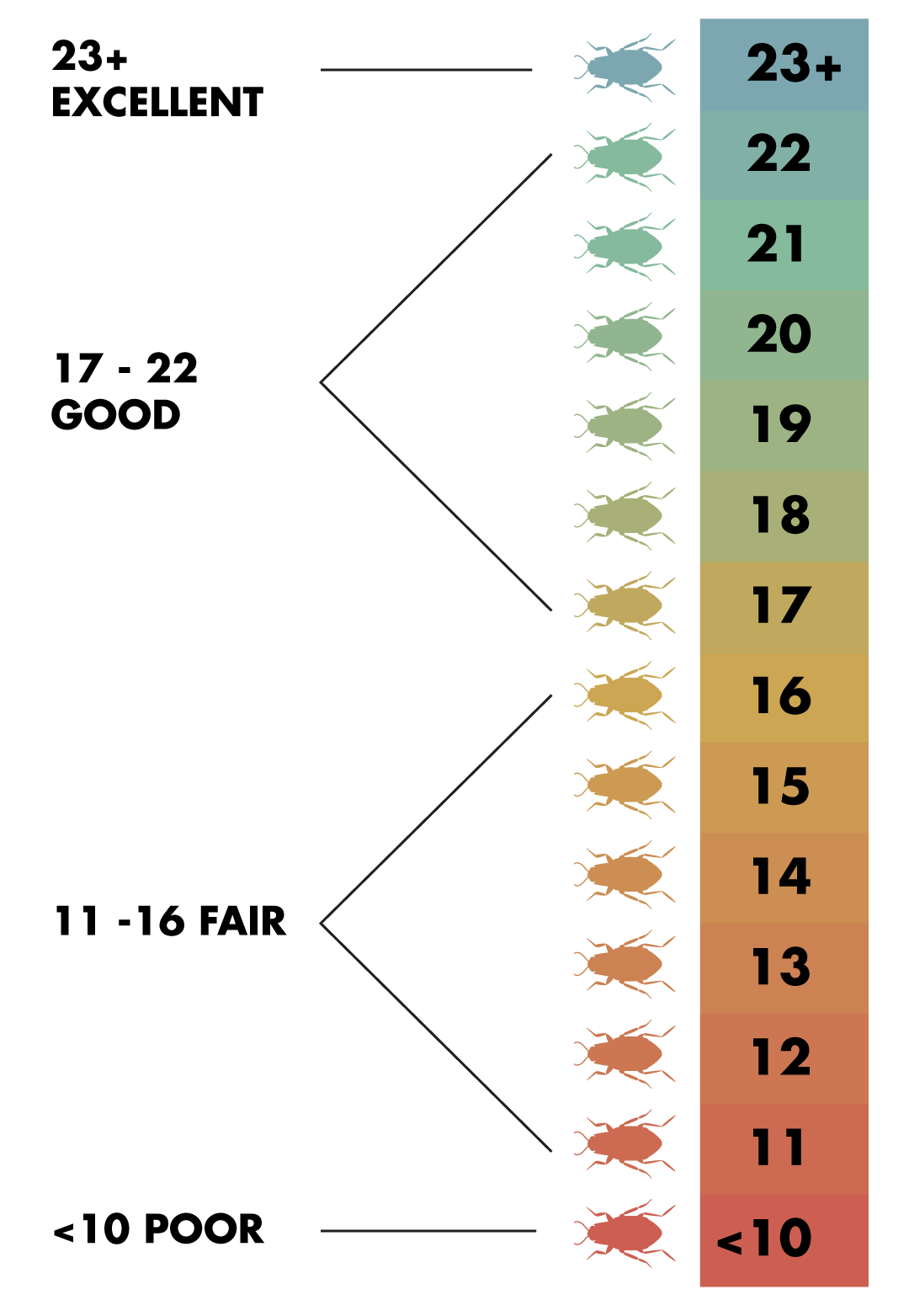
The water quality of the streams in your own backyard can be assessed using macroinvertebrates . Macroinvertebrates are animals that lack a backbone, are large enough to be seen with the naked eye, and live at least part of their lives in or on the bottom of a body of water. Macroinvertebrates can include mussels, snails, worms and insect larvae.
Macroinvertebrates live in the sand and mud, and on rocks, logs, sticks and vegetation in water bodies. Flowing water provides material on which the organisms feed. Rocks, logs, and plants provide nooks and crannies for the organisms to hide and a place for them to attach. There are thousands of different macroinvertebrate species in the Ohio River Valley, each with its own unique requirements for survival. Many require high levels of oxygen and can't tolerate toxic pollutants. However, some can tolerate very low oxygen levels or high toxicity and are known as pollution-tolerant species. Macroinvertebrates are relatively immobile. They cannot escape from changes in water quality, so if pollution occurs, macroinvertebrates are affected. Therefore, you can determine the how healthy a river, lake, or stream is by looking at the variety of organisms present. In general, the greater the diversity of organisms the better the water quality!
Macroinvertebrate indexes have been developed that allow citizen water quality monitors to calculate the health of the water body they are sampling based on the number of macroinvertebrate taxa they find. These indexes, which group macroinvertebrates according to their tolerance to pollution toxicity and/or low oxygen levels, focus on the number of taxa identified in a sample rather than the number of individuals identified in each taxa. Some taxa group organisms into a three groups according to their sensitivities, while others group organisms into four groups.

Elongated insect shape with distinctive head, legs, and tails.
1/2" to 1 1/2"
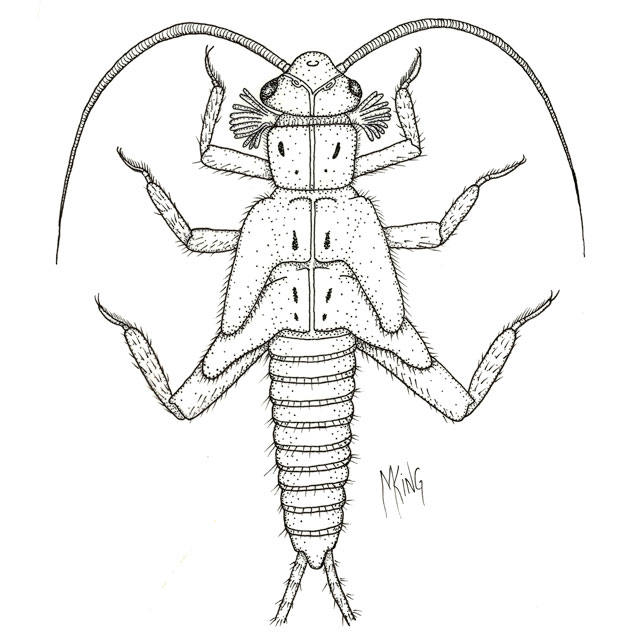
Can be predators or shredders that feed on plant material, algae, or detritus.
Incomplete metamorphosis; can spend 3-36 months in larval stage. After emerging, adults may live for up to a month.
Stonefly nymphs are often found clinging to leaf litter, rocks, algae, or other debris in a waterway. They are often confused with Mayfly nymphs, which typically have three tails instead of two. Stonefly nymphs do not have fluttering gills along their abdomen, which is a distinguishing characteristic of Mayfly nymphs.
Very Sensitive (Taxa 1)
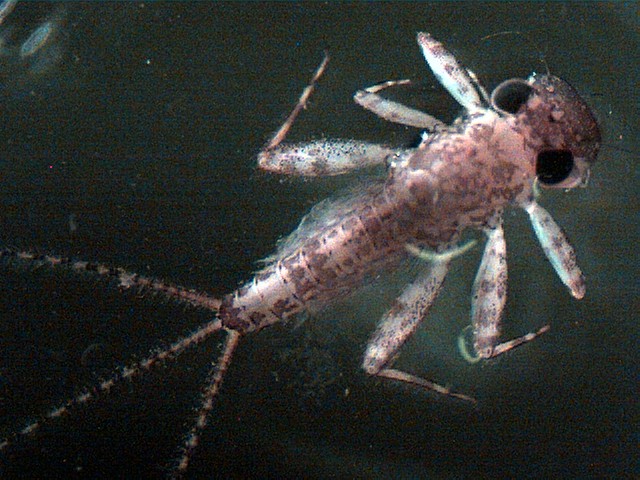
1/4" to 1 1/4"
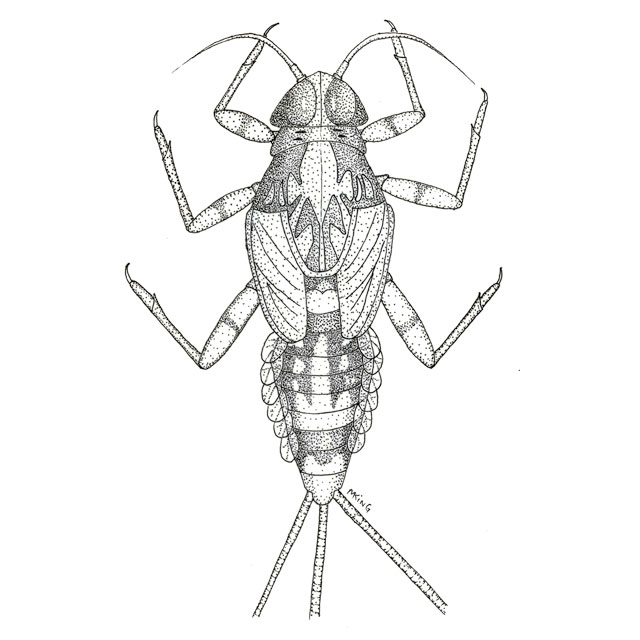
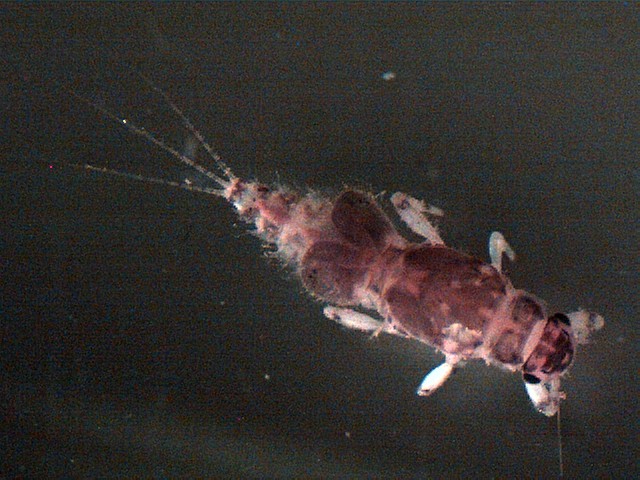
Herbivore or detritivore
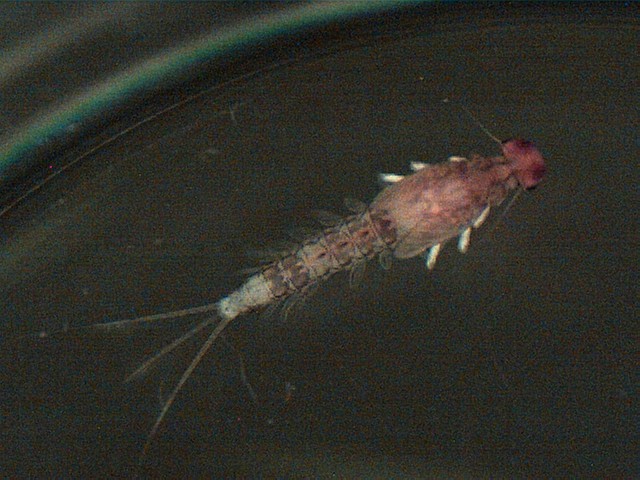
Incomplete metamorphosis; can spend 3-36 months in larval state. Adults emerge without mouthparts and do not eat, living for a very short time to mate and die. Some adult mayflies only live for a few hours.
Mayfly nymphs have fluttering gills along the abdomen which make them distinguishable from Stonefly nymphs. Their body shapes can vary according to their habitat:
Very Sensitive (Taxa 1)
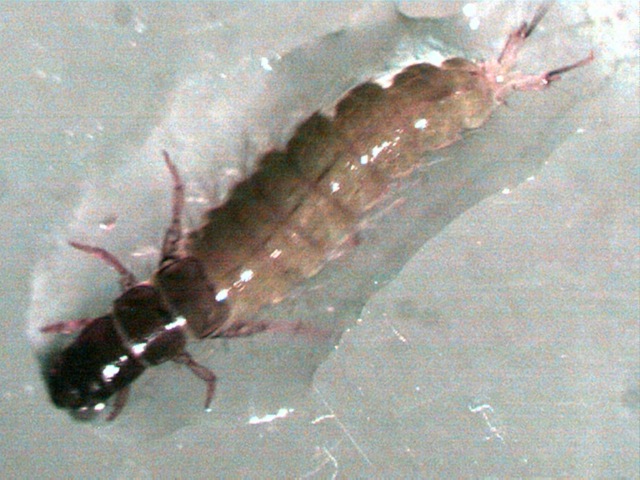
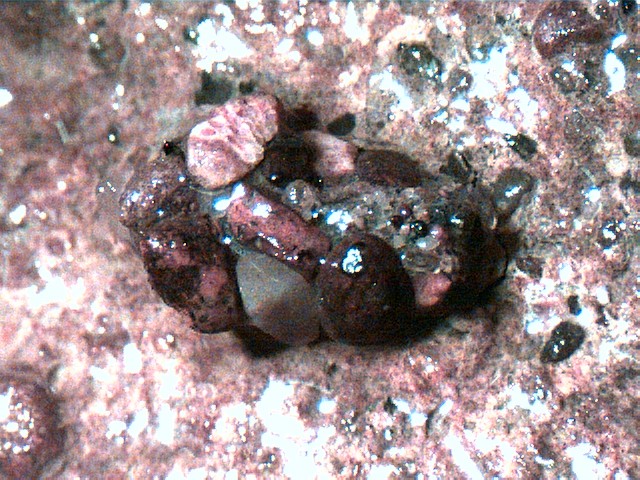
Caterpillar-like bodies with colors that may vary due to diet.
Microscopic to 1”
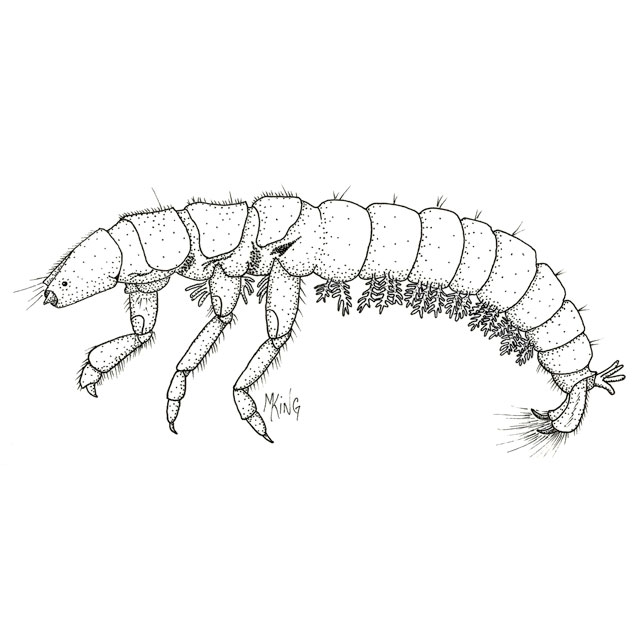
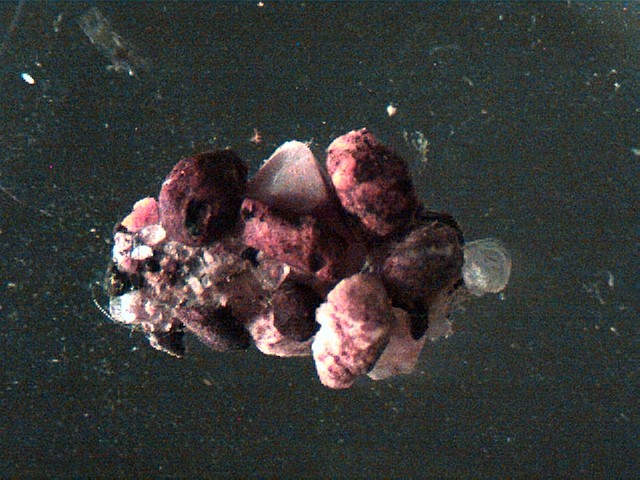
Shredders, feeding on plant material or detritus. Net Spinning Caddisfly larvae construct nets to filter small organic particles from the current.
Complete metamorphosis
There are three suborders of Caddisfly larvae. Some use silk to create nets that filter food from the current, some use silk as glue to construct protective cases out of leaves or rocks, and some lay down a strand of silk as they move. A protective case may look like a cluster of tiny stones stuck to a rock or other substrate, or a very small stick or leaf particle that “swims” through the water.
Very Sensitive (Taxa 1)

Resembles a large centipede with large chewing mouthparts on head.
3/4" to 4"
Predator
Complete metamorphosis
Larvae can live in the water for 3 to 36 months before pupating and emerging as adults, which may only live for a few days.
Dobsonfly larvae can be found between rocks and on rotting logs in the water. They can be quite startling if found. Adult females are capable of inflicting painful bites.
Very Sensitive (Taxa 1)
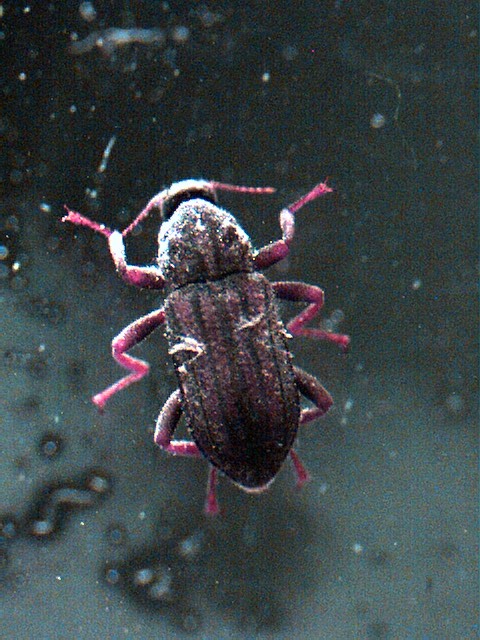
(Larva) Very small, elongated bodies.
(Adult) Very small, aquatic insects that are very dark or black.
(Larva) Usually less than ½”
(Adult) Usually less than ½”
(Larva)
(Adult)
(Larva) Gatherer collector or grazer
(Adult) Gatherer collector
Complete metamorphosis
Both Riffle Beetle larvae and adults are very small and are both aquatic, though it is more common to find adults than it is larvae.
Somewhat Tolerant (Taxa 1)
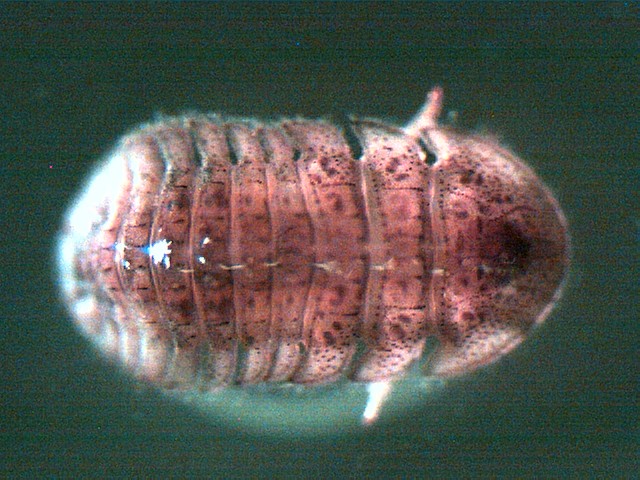
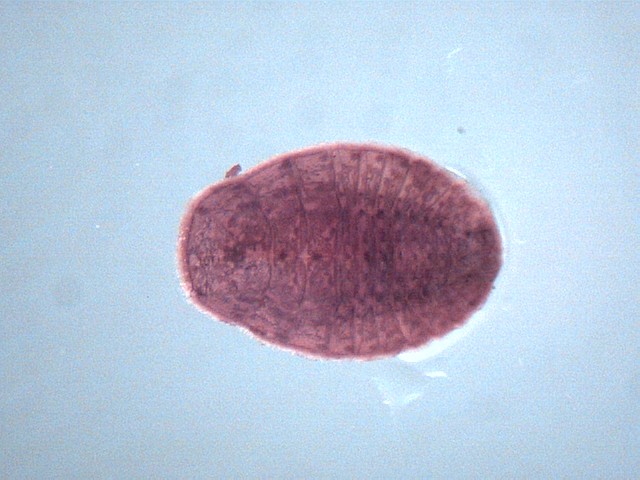
Small, plated body that is round or oval-shaped
1/4"
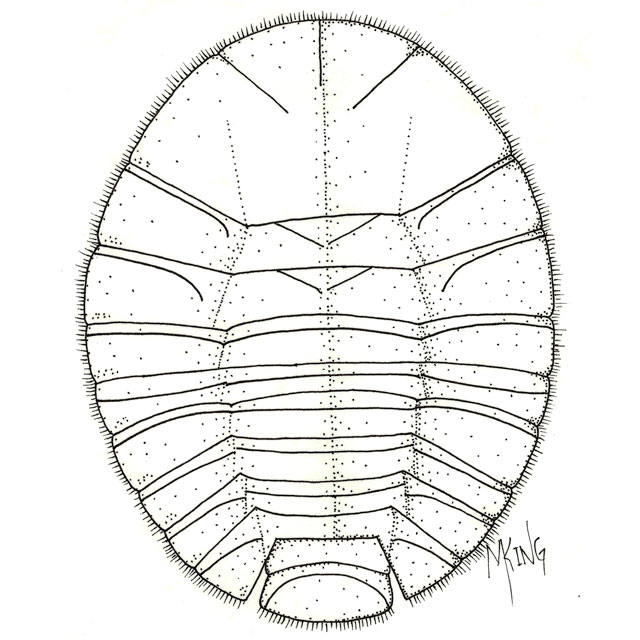
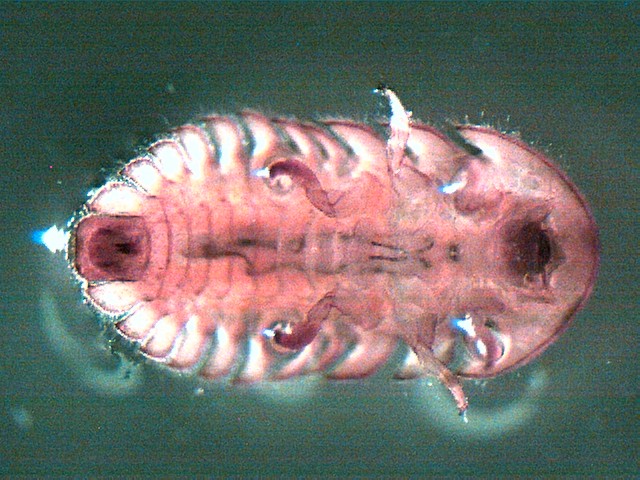
Grazer, feeds on periphyton (algae) that grow on rocks or other substrates in the water.
Complete metamorphosis
Water Penny Beetle larvae are often found “suctioned” to rocks, leaves, and submerged logs in a stream. They cling to rocks and move around in circles, gathering algae, diatoms, and plant material. Moving into a current while clinging to rocks allows them to get oxygen and food simultaneously.

Adults are not truly aquatic, but can be found in rocks or other substrates sticking out of the water.
Very Sensitive (Taxa 1)
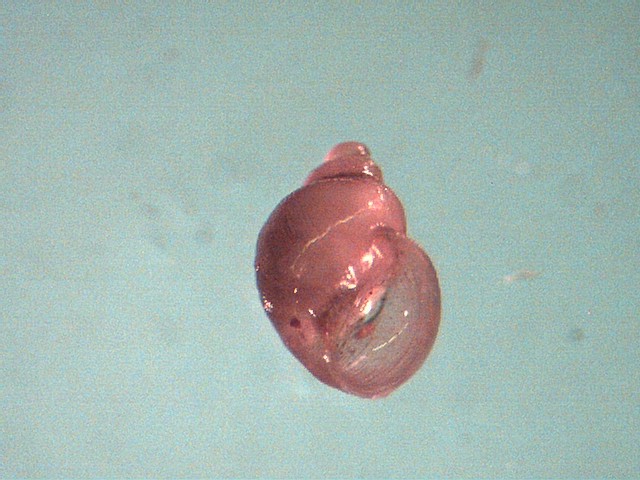
Easily identifiable as a snail. Spiral-shaped shell has an aperture (opening) on the right when pointed tip of shell is held upright.
1/16" to 1 3/4"
Grazer
Unlike Left-handed Snails, which are mostly hermaphroditic, Right-handed Snails have distinct sexes. They resemble adults when they hatch from eggs.
These animals can be found suctioned to rocks, leaves, wood, or other submerged substrates. They require high levels of oxygen in the water since they breathe using gill structures, which are located inside of their shells. They should not be confused with Left-handed (Lunged) Snails, which have an opening on the left when the pointed end of the shell is held upright. Snails with shells that do not coil up into a point are also counted as Left-handed Snails, and NOT counted as Gilled Snails.
Very Sensitive (Taxa 1)
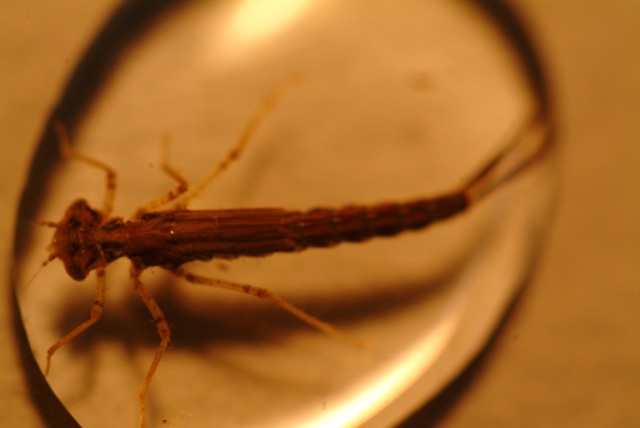
Elongated insect body with three “paddle” shaped tails
1/2" to 1"
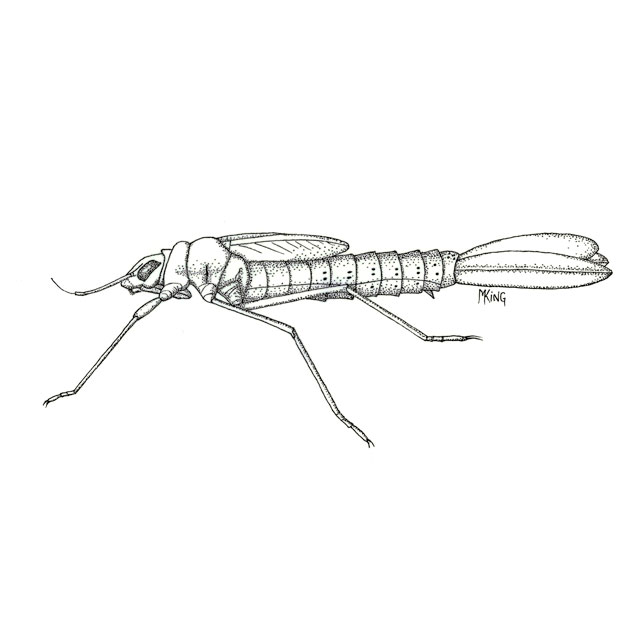
Predator
Incomplete metamorphosis; larvae may spend up to four years in the water.
The modified gills at the end of the abdomen create a large and exposed surface area from which to extract oxygen from the water. Since Damselfly larvae are predators, they can often be found sitting motionless on submerged vegetation in the water.
Somewhat Sensitive (Taxa 2)

Overall shape is flattened and more robust than other insect larvae, with a wide abdomen.
1/2" to 2"
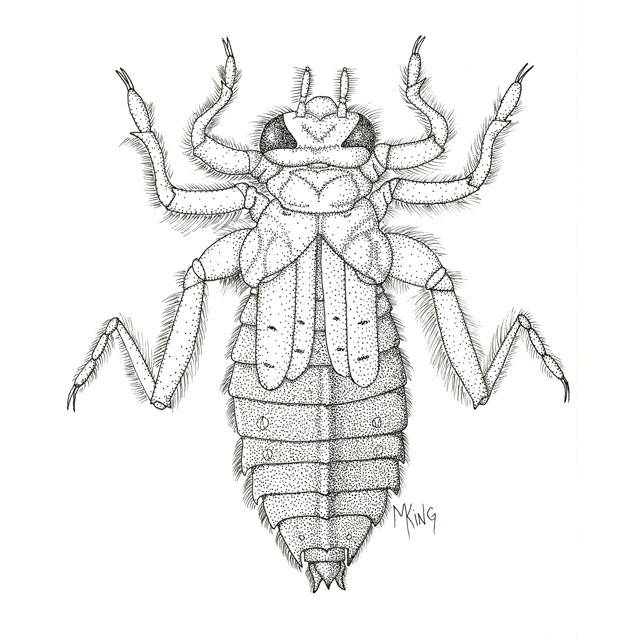
Predator
Incomplete metamorphosis; larvae can spend 1-4 years in the water.
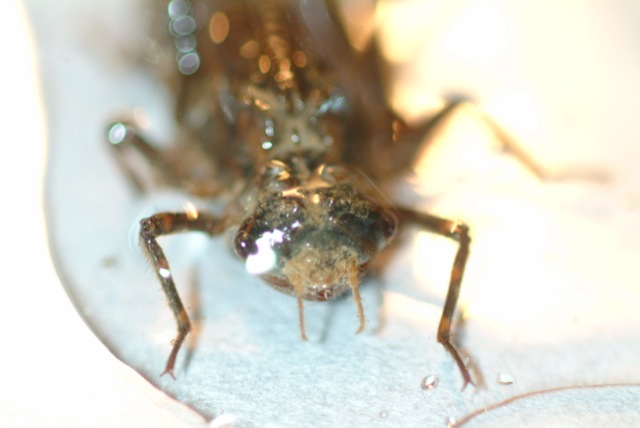
Dragonfly nymphs may look like armored pieces of tree bark with legs, bearing little resemblance to adults. They can often be found clinging to vegetation. When they are ready to capture their prey, which can include fish, they use “jet propulsion” to move quickly forward by pushing water out of the back of their abdomens.
Somewhat Sensitive (Taxa 2)
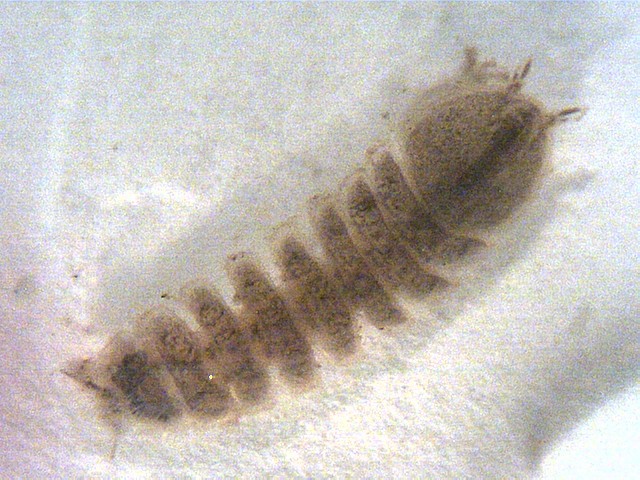
Hard bodies are flattened with seven legs on each side, resembling a Roly Poly or Pill Bug.
1/32" to 1/2"
Scavenger, collector
These animals can often be found crawling slowly on rocks, vegetation, or debris.
Somewhat Sensitive (Taxa 2)

Laterally compressed, resembles a shrimp.
3/16" to 3/4"
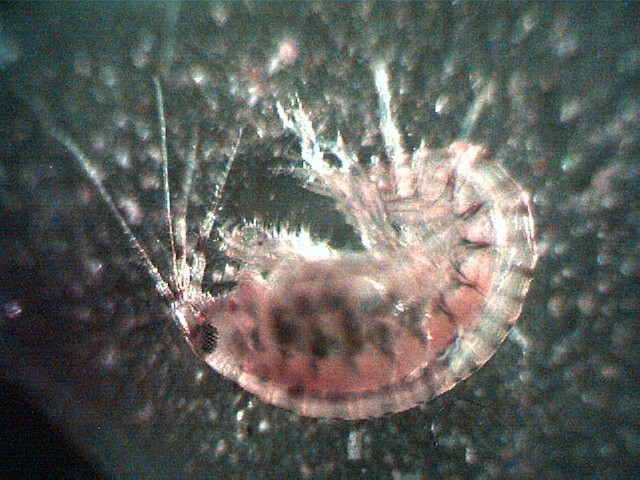
Gatherer, collector
Scuds are often found rapidly swimming on their sides through the water and are also referred to as “side swimmers”.
Somewhat Sensitive (Taxa 2)

Large, segmented body that is worm-like and plump.
1/3" to 3"
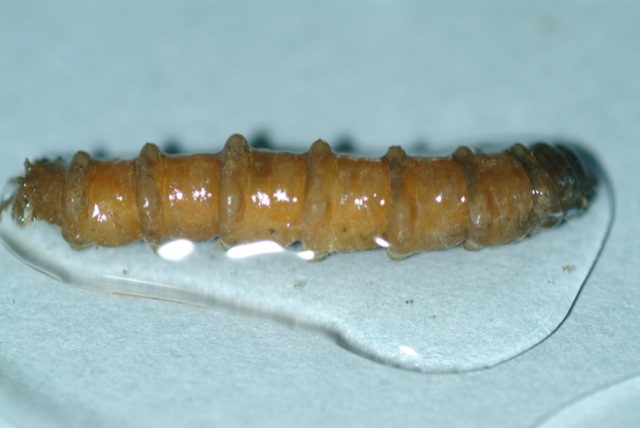
Shredder, feeding on decomposing vegetation. Some crane fly larvae can be predaceous.
Complete metamorphosis; can spend six weeks to five years in the water as larvae. Once emerging, adults may only live for a few days.
These large, "juicy" larvae can be found in vegetation, in decaying leaves, orunder rocks in a stream. Adults resemble mosquitoes with long, dangly legs, but do not bite. In fact, many winged adults do not eat and only live for a few days.
Somewhat Sensitive (Taxa 2)

Two hinged valves, or shells.
1mm to up to a meter in length. Size can vary greatly depending on the species.
Filter feeder, uses two "siphons" for intake and output of water.
These animals are not insects, so they do not undergo metamorphosis. Most mussel species (except Zebra Mussels) spend their early larval stages developing in fish gills before dropping off and maturing on stream or river bottoms.
These animals are mostly sedentary, burying themselves in mud. Zebra Mussels (which are small, with alternating dark and light-colored stripes) are an exotic species that use byssus threads to attach to rocks, vegetation, or other substrates, including native mussels.
Somewhat Sensitive (Taxa 2). Only live specimens can be counted in the index. Zebra Mussels or other exotic mussels should be noted in the Summary.

Lobster-like appearance
1/2 " to 6"
Crayfish consume a wide variety of food. They can be grazers, feeding on algae or vegetation, or predators.
Juveniles are essentially replicas of adults. Young will often remain on the mother for a short period of time before moving off to start life as miniature adults, molting multiple times before they reproduce.
They are capable of using the claws and legs to capture prey . They can rapidly swim backwards to avoid being captured.
Somewhat Sensitive (Taxa 2). Exotic Rusty Crayfish should be noted in the Summary.
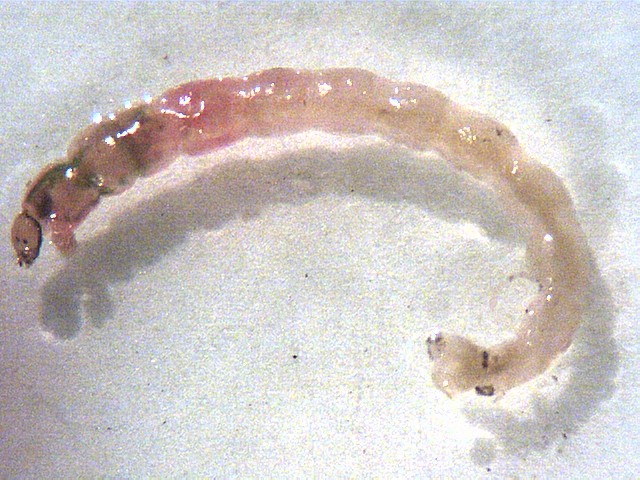
Slender, slightly curved, segmented body with distinct head and prolegs near head and on the abdomen.
Up to 1/4"
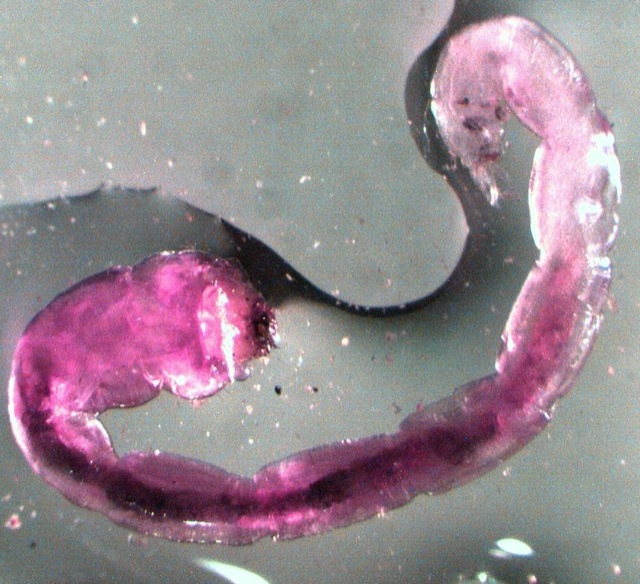
Gathering collector or grazer, feeding on organic matter such as algae or decaying plants.
Complete metamorphosis
Midge larvae can survive poorly oxygenated conditions in the water by absorbing oxygen through the skin. Oxygen is creating by wriggling their bodies back and forth, so they can appear very “squirmy” when collected. Midges that are red in color are Blood Midges and have a separate entry in this index.
Somewhat Tolerant (Taxa 3)
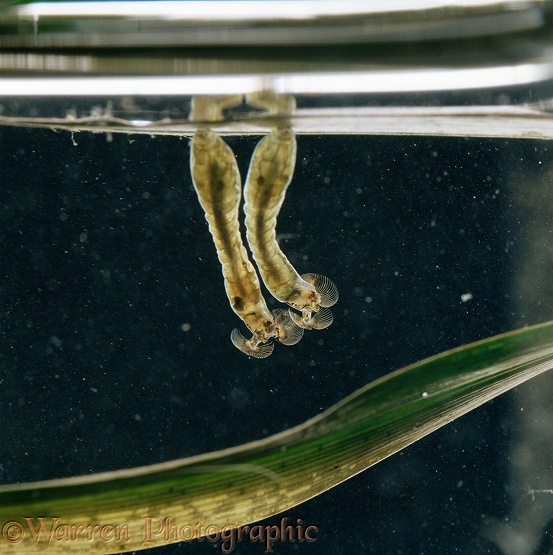
Elongated, worm-like body that is wider at one end than the other
Up to 1/4"
Filter collector, feeding on phytoplankton and zooplankton
Complete metamorphosis
Can be found attached to rocks and submerged vegetation, moving back and forth to filter feed.
Somewhat Tolerant (Taxa 3)
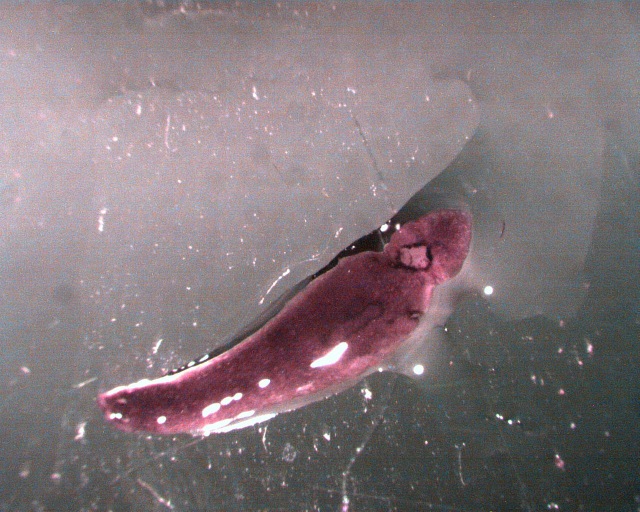
Small and flat, with an arrow-shaped head that can be seen when animal extends its body.
1/8" to 2"
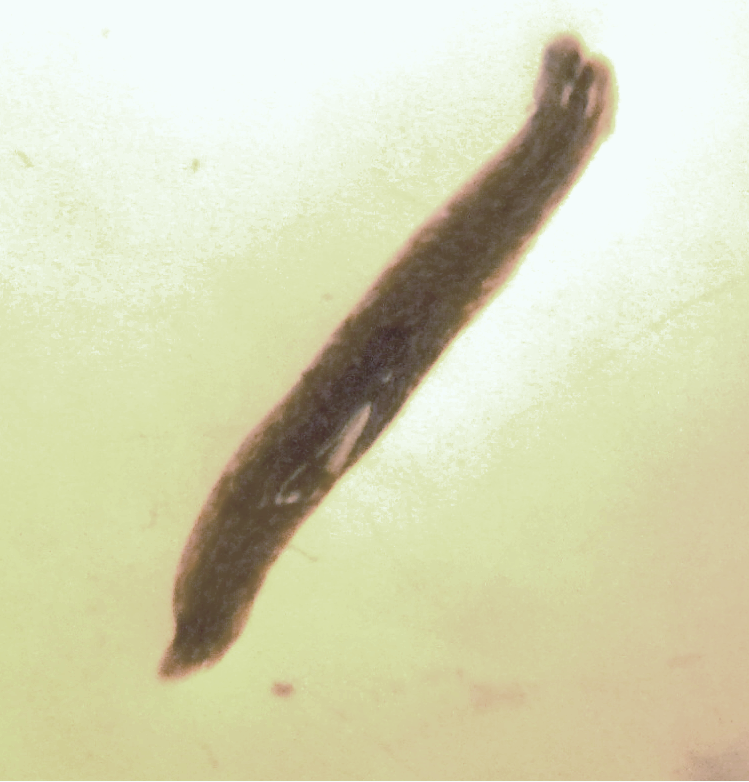
Gathering collector or predator, feeding on live or dead organisms using a pharynx that extends from its mouth.
Capable of sexual and asexual reproduction. Adults and offspring look very similar.
Often appear as soft, dark “blobs” attached to rocks, vegetation, or leaf matter. The arrow-shaped head and eyespots can be seen when animal extends its body. Planaria absorb oxygen through their skin.
Very Tolerant (Taxa 3)
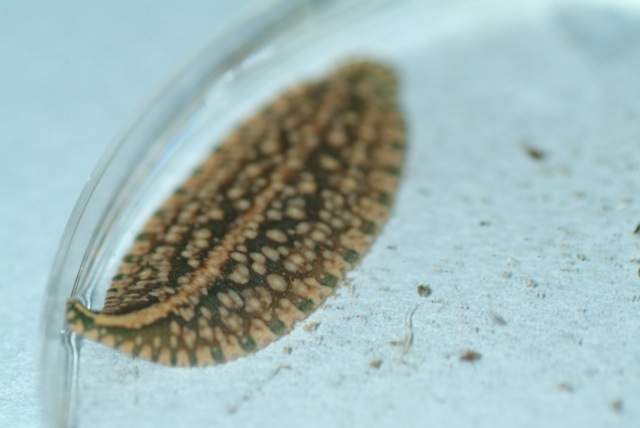
Flat segmented body that is wider toward the back end.
1/4" to 2"
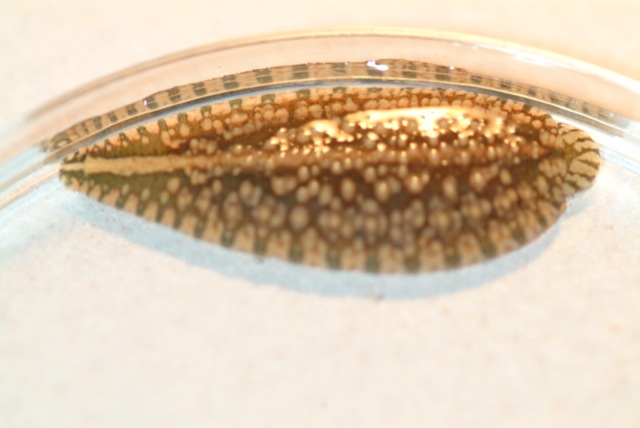
Some are collectors, feeding on organic debris. Some are predaceous or parasitic, feeding on fish and other animals.
Most adult leeches have both male and female reproductive structures. Juvenile leeches hatch from cocoons and resemble adults.
Aquatic leeches can be found in slow-moving water and absorb oxygen through the skin. Leeches move like an inch worms, attaching the "head" sucker and bringing up the rear.
Very Tolerant (Taxa 3)
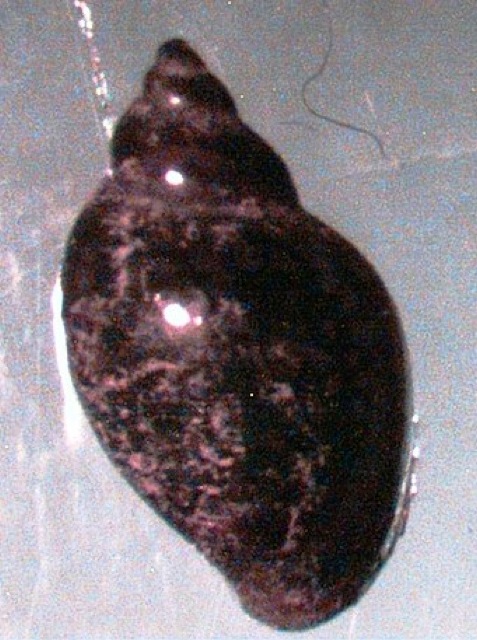
Easily identifiable as a snail. Spiral-shaped shell has an aperture (opening) on the left when pointed tip of shell is held upright. Orb Snails, which do not spiral into a tip, are also counted as Left-handed snails.
Up to 1/2"
Orb snails up to 2"
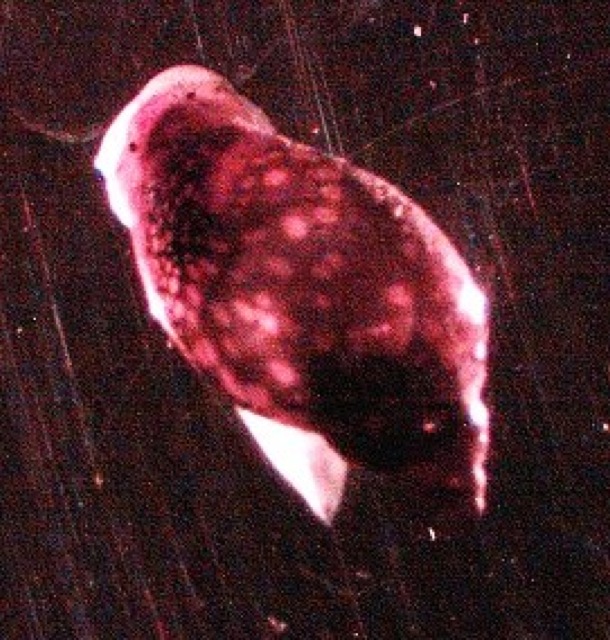
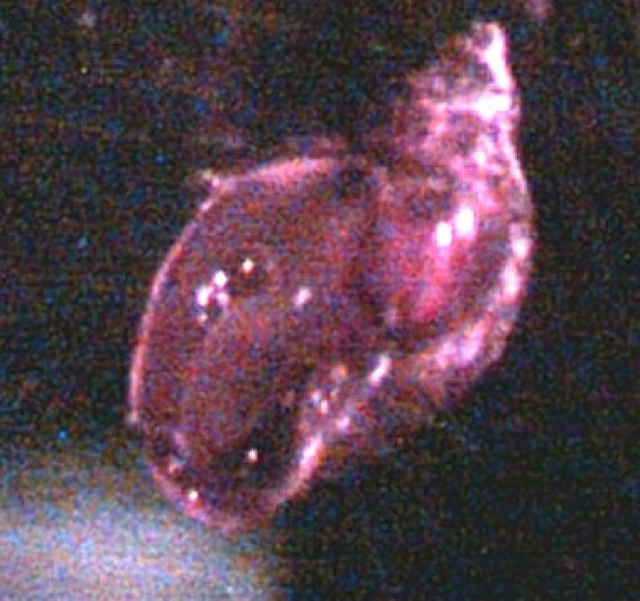
Grazer, uses radula (rasping tongue) to scrape algae and other matter from substrate.
Most species of Left-handed Snails are hermaphroditic. Small snails hatch from eggs and resemble adults.
Instead of gills, Left-handed Snails use a lung-like structure with which they obtain oxygen from the air and can thus survive in poorly-oxygenated water.
Very Tolerant (Taxa 4)

True segmented worms.
1/4" to 2"
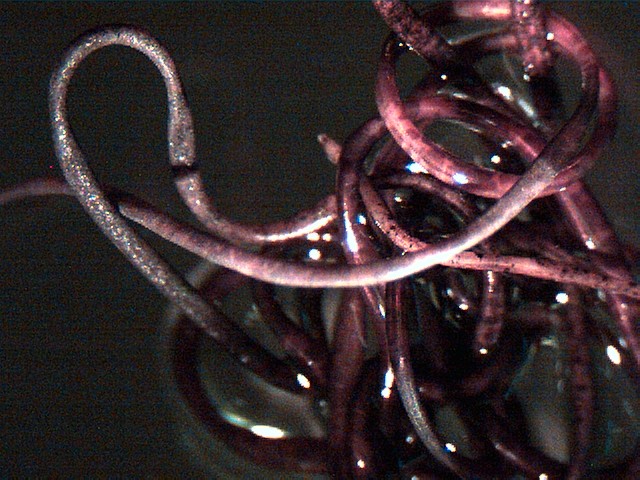
Can be collectors, grazers, or shredders, feeding on a variety of organic matter
Brown to red in color, aquatic worms can easily be confused with the blood midge; however, they do not have prolegs and do not “squirm” like midges. Instead they tend to slide smoothly along a surface. They do, like midges, absorb oxygen through their skin.
Very Tolerant (Taxa 4)

Elongated, slender, slightly curved, segmented worm like body with a small head capsule visible.
Up to 1/4"
Bright red due to high hemoglobin levels this slender worm like animal has prolegs near the head and hook like appendages at the rear.
Very squirmy when collected you can often see the these animal curling and uncurling as they "swim" through the bin.
Very Tolerant (Taxa 4)
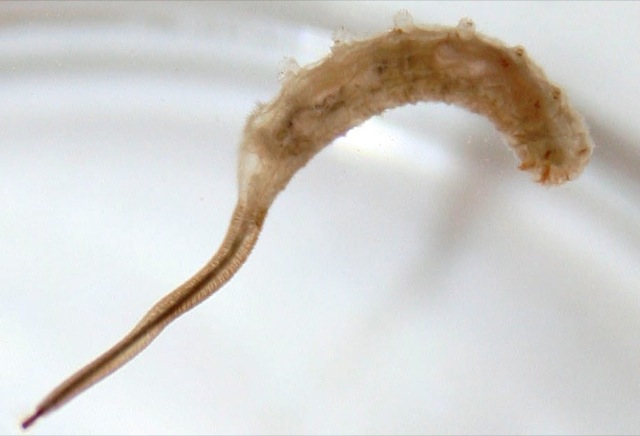
Resembles a maggot with a long tail.
Up to 1/2”, but may exceed 2” when tail is fully extended
Collector
Complete metamorphosis
Can often be found in very stagnant water.
Very Tolerant (Taxa 4)